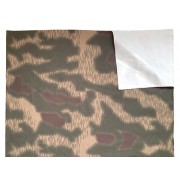How to choose the size?
Sale! Extremely low price!
Size of pants is suitable to the size of the jacket, i.e. buy the jacket and pants in one size. If you wear size 52, then you need to buy 52, you shouldn't take the next larger size "for the winter form", everything is already added. The normal height for the jackets and pants is 180 cm. The height is not so important for pants, because they are worn over boots (or tucked inside). Germans generally had only 3 sizes. We did 5, considering the requirements of the modern reenactor.
You can choose the size remotely by choosing the size of the table itself. You will need a flexible meter or at least a rope. Measure similar winter pants that fit you.
• Flat width — you put pants onto the floor and measure it from the left to the right side seam on waist level; these pants have waist level where your lower rib is.
• Lenght — total lenght along side seam.
• Depth — along the front from waist to the crutch.
• Waist around — maximum waist you put in these pants; measure your waist wearing usual summer uniform; measure where your standart belt should be worn (under lower rib); the first measurement is bare, the second measurement is over the shirt + sweater + jacket (as it's right to wear these pants).
All measurements are in centimeters. Devide numbers to 2,54 to have inches.
| Size | Flat width | Length | Depth | Waist around |
| 48 | 48 | 110 | 41,5 | 81/86 |
| 50 | 50 | 111 | 42 | 87/92 |
| 52 | 52 | 112 | 42,5 | 93/98 |
| 54 | 54 | 113 | 43 | 99/104 |
| 56 | 56 | 114 | 43,5 | 105/110 |
You can choose a size from those we have in stock. If your size is not available, means it's not in stock now.
Description
Exact replica of German Wehrmacht 1944-45 reversible winter pants. One side is white and another is camouflaged. The pants are a part of German winter uniform set along with similar jacket. Dense cotton fabric and historically correct insulation. No synthepon or modern materials as an insulation! Germans collected old clothes from cloth, cotton and viscose, crushing it by the special machine and made a cloth (like a bad quality blanket). Such a cloth they used for insulating clothes.
We offer a responsibly copied example from German samples. Templates developed "from scratch" by order and under the control of the shop "Replica". Items were sewn at the factory by professionals using serious sewing equipment. This high-quality copy is designed and sold in the shop "Replica" only.
We accurately followed all original details during reproducing. High-quality buttons are sewn, buttonholes' treatment as on German originals. The model features straight-cut pocket flaps and knee reinforcements. Pockets are accessible from both winter and summer side. Pocket valves are 4-pointed, as usual for the winter uniform of the Wehrmacht. Glass (plastic) buttons on both sides (black and white respectively), and shaped granular aluminum — on the pockets, Feldgrau color painted. The trouser leg ends have long side slits with a tape to wear over boots. Pants are worn over a summer uniform, held on suspenders. The waist is adjustable with a drawstring at the back.
Pants are ink marked: size, producer's code (RB.Nr.) and date X44 (October 1944).
Historical reference.
There were some variations of "Marsh" camouflage (original name: Sumpftarn, also Swamp in English). The first appeared in 1943, it was essentially a "Splinter" with blurred edges and warmer color scheme. At the same time appeared a "blurred Splinter" in standard colors. And to 1944 "Swamp" began to be shapeless. We used this type here.





























![[on order] Commander's belt dark brown [on order] Commander's belt dark brown](https://reenact.store/image/cache/2b86ca2f77f80e0d70dcba64fa709be8.jpg)
![[on order] Commander's belt set M32 [on order] Commander's belt set M32](https://reenact.store/image/cache/5b08720a7bf7f97380cb4a7affc058d6.jpg)